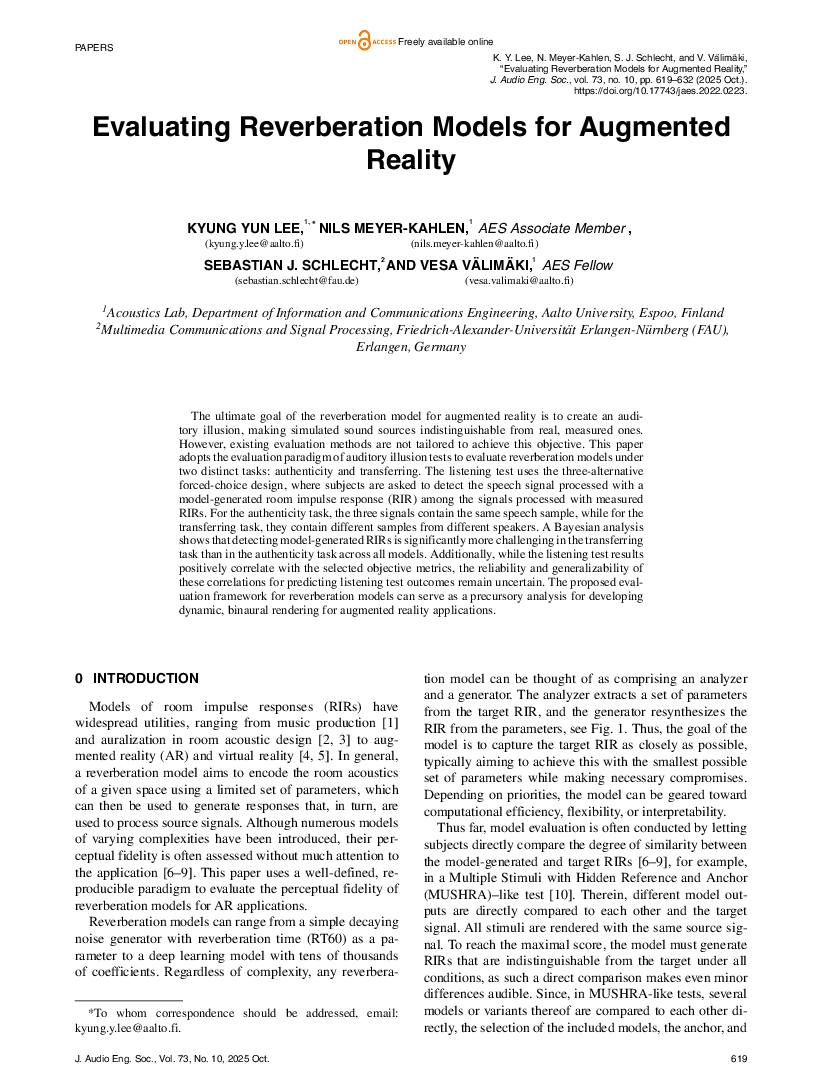Home / Publications / E-library page
You are currently logged in as an
Institutional Subscriber.
If you would like to logout,
please click on the button below.
Home / Publications / E-library page
Only AES members and Institutional Journal Subscribers can download
The ultimate goal of the reverberation model for augmented reality is to create an auditory illusion, making simulated sound sources indistinguishable from real, measured ones. However, existing evaluation methods are not tailored to achieve this objective. This paper adopts the evaluation paradigm of auditory illusion tests to evaluate reverberation models under two distinct tasks: authenticity and transferring. The listening test uses the three-alternative forced-choice design, where subjects are asked to detect the speech signal processed with a model-generated room impulse response (RIR) among the signals processed with measured RIRs. For the authenticity task, the three signals contain the same speech sample, while for the transferring task, they contain different samples from different speakers. A Bayesian analysis shows that detecting model-generated RIRs is significantly more challenging in the transferring task than in the authenticity task across all models. Additionally, while the listening test results positively correlate with the selected objective metrics, the reliability and generalizability of these correlations for predicting listening test outcomes remain uncertain. The proposed evaluation framework for reverberation models can serve as a precursory analysis for developing dynamic, binaural rendering for augmented reality applications.
Author (s): Lee, Kyung Yun; Meyer-Kahlen, Nils; Schlecht, Sebastian J.; Välimäki, Vesa
Affiliation:
Acoustics Lab, Department of Information and Communications Engineering, Aalto University, Espoo, Finland; Acoustics Lab, Department of Information and Communications Engineering, Aalto University, Espoo, Finland; Multimedia Communications and Signal Processing, Friedrich-Alexander-Universität Erlangen-Nürnberg (FAU), Erlangen, Germany; Acoustics Laboratory, Department of Information and Communications Engineering, Aalto University, Espoo, Finland
(See document for exact affiliation information.)
Publication Date:
2025-10-01
Import into BibTeX
Permalink: https://aes2.org/publications/elibrary-page/?id=23025
(1131KB)
Click to purchase paper as a non-member or login as an AES member. If your company or school subscribes to the E-Library then switch to the institutional version. If you are not an AES member Join the AES. If you need to check your member status, login to the Member Portal.

Lee, Kyung Yun; Meyer-Kahlen, Nils; Schlecht, Sebastian J.; Välimäki, Vesa; 2025; Evaluating Reverberation Models for Augmented Reality [PDF]; Acoustics Lab, Department of Information and Communications Engineering, Aalto University, Espoo, Finland; Acoustics Lab, Department of Information and Communications Engineering, Aalto University, Espoo, Finland; Multimedia Communications and Signal Processing, Friedrich-Alexander-Universität Erlangen-Nürnberg (FAU), Erlangen, Germany; Acoustics Laboratory, Department of Information and Communications Engineering, Aalto University, Espoo, Finland; Paper ; Available from: https://aes2.org/publications/elibrary-page/?id=23025
Lee, Kyung Yun; Meyer-Kahlen, Nils; Schlecht, Sebastian J.; Välimäki, Vesa; Evaluating Reverberation Models for Augmented Reality [PDF]; Acoustics Lab, Department of Information and Communications Engineering, Aalto University, Espoo, Finland; Acoustics Lab, Department of Information and Communications Engineering, Aalto University, Espoo, Finland; Multimedia Communications and Signal Processing, Friedrich-Alexander-Universität Erlangen-Nürnberg (FAU), Erlangen, Germany; Acoustics Laboratory, Department of Information and Communications Engineering, Aalto University, Espoo, Finland; Paper ; 2025 Available: https://aes2.org/publications/elibrary-page/?id=23025
@article{lee2025evaluating,
author={lee kyung yun and meyer-kahlen nils and schlecht sebastian j. and välimäki vesa},
journal={journal of the audio engineering society},
title={evaluating reverberation models for augmented reality},
year={2025},
volume={73},
issue={10},
pages={619-632},
month={october},}